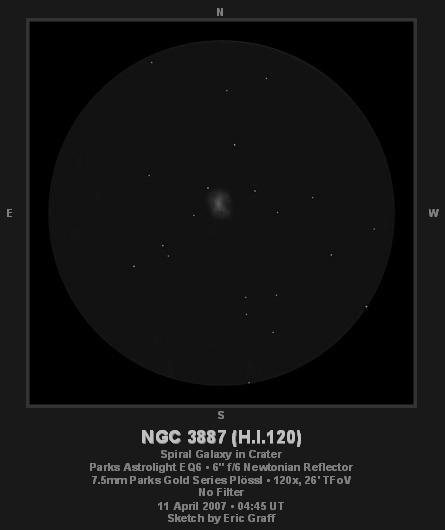
NGC 3887 in the constellation Crater
Sketch and Details by Eric Graff
NGC 3887 lies over 10.5° south and just over 1° east of NGC 3818. If you have an equatorial mount, the ten-degree southward adjustment might be the easiest way to reach this object quickly. If you prefer to star hop, you can either return to Theta Crateris to follow a line of widely spaced stars trending southward and slightly east: 3.4° SSE to Iota Crateris; 1.3° SSE to 6th magnitude HD 101369; 2.2° almost due south to 6th magnitude HD 101370; and finally 1.8° due east to NGC 3887. You might also consider a star-hop taking you through the double star H VI 115 and the galaxy NGC 3962 (nos. 8 and 9, below).
However you get here, the trip will be worth your trouble, as NGC 3887 is the brightest spiral galaxy in the constellation of Crater. This galaxy appears as a moderately sized amorphous glow of diffuse nebulosity in an attractive field of view. The faint field stars are arranged in a “V” like pattern with the galaxy nestled within the figure. NGC 3887 displays a brighter central region without a nucleus and a patchy outer halo somewhat suggestive of coarse spiral arm fragments. The view at 120x magnification reminds me of a smaller, fainter version of NGC 2403 in Camelopardalis.
NGC 3887 was discovered visually by William Herschel using a 18.7-inch reflector on December 31, 1785. It was catalogued as the 120th entry in the discoverer’s list of “Bright Nebulae.” Photographically, NGC 3887 is a beautiful object characterized by a small bright nucleus, a smooth oval-shaped bar with dark lanes and several knotty, branching spiral arms. The oval-shape of the central bar is atypical and it is only the presence of two thin straight dust lanes emerging from opposite sides of the nucleus. The largest HII regions (emission nebulae) have diameters of about 2″. Each of the two spiral arms may be traced for about 300° before disappearing. The arms are quite lumpy, exhibiting features much larger than typical star-forming regions and it is these features that trace the spiral arms beyond 180°. NGC 3887 lies at a distance of about 43 million light-years.

Eric,
Very enjoyable and informative read that accompanies this stunning face on galaxy sketch.
Frank